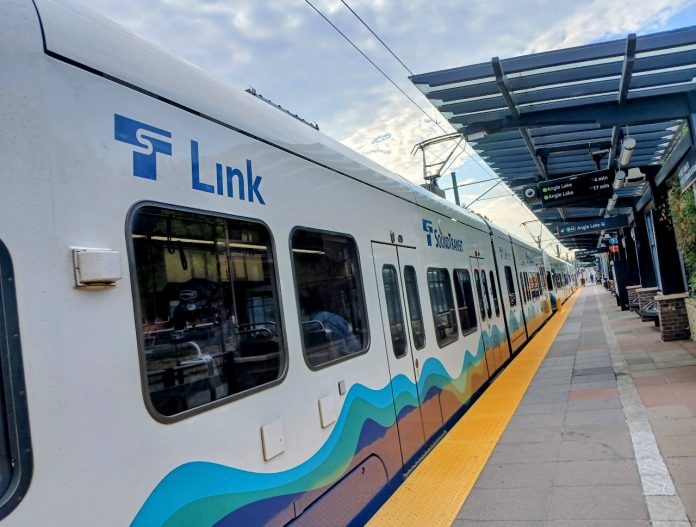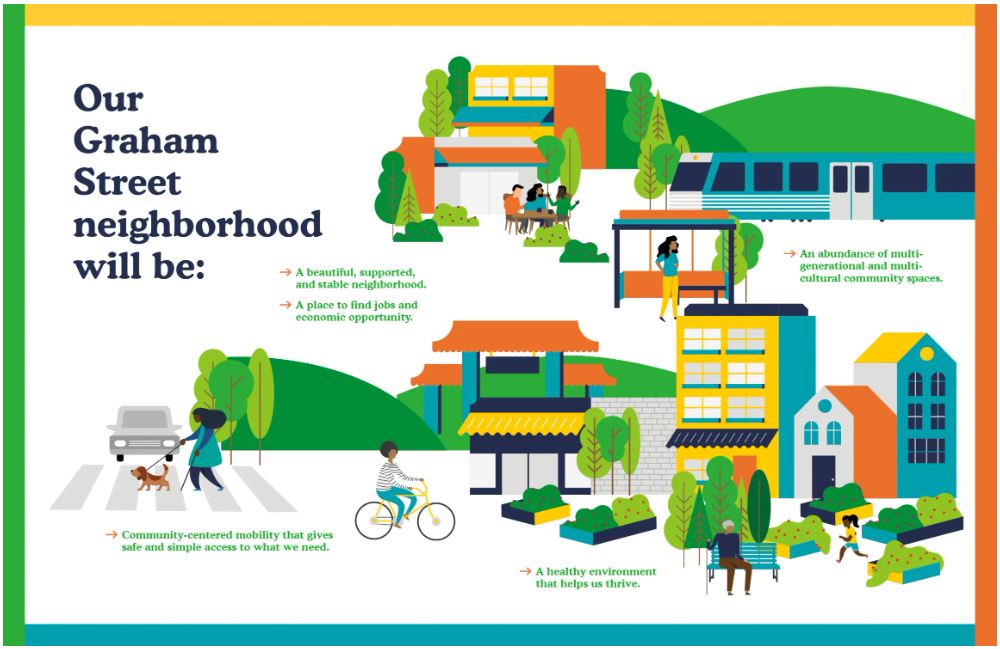
As the Sound Transit board starts to seriously grapple with the agency’s long-term budget deficit, eye-popping cost estimates to build two new light rail stations along existing segments of the 1 Line are likely to raise questions about whether those projects still make sense.
The two stations, at Graham Street in Seattle’s Rainier Valley and near Boeing Access Road in Tukwila, have been eyed for construction for more than 25 years, filling in some of the most sizable gaps in the expanding light rail network. But Sound Transit initially skipped over both to reduce costs and ensure its first light rail line, between SeaTac Airport and Downtown Seattle, remained on track.
In 2016, voters approved getting both stations across the finish line as part of the Sound Transit 3 (ST3) ballot measure, along with the accelerated N 130th Street, renamed Pinehurst Station, set to open next year. But inflation has taken its toll on estimated costs. Sound Transit is advancing designs and getting a better handle on expected costs.
Graham Street Station has gone from a $124 million in 2024 to $175-$200 million in the latest estimate, and the cost for Boeing Access Road has skyrocketed from $279 million to a staggering $425 to $475 million.

The forthcoming Pinehurst Station, located between Northgate and Shoreline South, will cost Sound Transit $144 million, which at this point looks like a steal compared to these other pending projects. Out of the three stations, Graham Street and Pinehurst are expected to serve similar ridership by the time the full ST3 build-out is completed: 3,100 to 4,600 daily riders at Pinehurst and 2,700 to 4,100 at Graham Street. Boeing Access Road, on the other hand, is only expected to bring in around 2,100 daily riders.
On a per-rider basis, Graham Street’s costs are set to come in at just under $50,000 per daily rider, compared to around $42,000 for Pinehurst. At its high-end cost of $475 million, Boeing Access Road would cost more than $225,000 per daily rider, nearly five times as much. As the work of the Enterprise Initiative looks high and low for cost savings, these two stations — especially Boeing Access Road — are likely to be back under the microscope.
Unique project cost drivers
In a memo circulated late this summer outlining the new cost estimates across the ST3 portfolio, Sound Transit Deputy CEO Terri Mestas laid out some of the “unique project cost drivers” impacting the two infill stations. There are the work restrictions that exist when the agency is building a new station on an operating line, in order to continue to provide an “acceptable level of service” for existing riders. And the fact that Sound Transit did not acquire the property it needs to build either station when the 1 Line was originally built, nor were utilities relocated at that time in anticipation of the future stations.
At Boeing Access Road, a traction power substation serving the existing 1 Line potentially needs to be relocated as an expensive project add-on, and at Graham Street extra costs are expected to come from adjusting the station’s footprint to accommodate pedestrian gates intended to improve safety along the at-grade alignment.

Sound Transit has also started to look at potential cost-saving measures for each station, though the agency hasn’t yet released full estimates for savings. At Graham Street, Sound Transit could replace rail embedded in the roadway with ballasted track, or skip the crossover tracks that are required by internal agency standards. Only allowing riders to enter the station from one side of the station would also bring costs down.
For Boeing Access Road, Sound Transit could design around the existing power substation, and drop plans for escalators to and from the platform, only relying on stairs and elevators. For both stations, the agency is looking at shrinking the amount of weather protection available at the platform for riders.
But near the top of the list of proposals to reduce costs would be shutting down 1 Line service to complete construction as soon as possible, a move that would also require shutting down MLK Jr Way S in the case of Graham Street. That would likely prove even more unpalatable that some of the other options on the table.
Advocates pushback on abandoning stations
Putting the brakes on either project would have big impacts. The City of Seattle is deep in station area planning around Graham Street, with recommendations set to be released next year in the form of an action plan looking at how to “improve transportation access, support housing stability, and create welcoming public spaces” around the future light rail station.

The community-based nonprofit Puget Sound Sage has been heavily involved in planning efforts as well, partnering with community groups to create a neighborhood vision focusing on combatting displacement and expanding opportunities for communities of color. Abandoning Graham Street Station could lead to complaints that Rainier Valley is once again bearing the brunt of cuts and getting substandard light rail service.
Boeing Access Road has long been a priority for the City of Tukwila, directly serving the North Tukwila Manufacturing and Industrial Center (MIC) and the 25,000 expected to be working there by 2035. Despite its relatively low ridership forecast, the station is expected to be a transfer point for riders across a fairly wide catchment area.

Brandon Miles, Director of Strategic Initiatives and Government Relations for the City of Tukwila, pointed out that costs would have been much lower to complete the station with the rest of the 1 Line when it was originally constructed.
“The Boeing Access Road Station is a cautionary tale of what happens when we defer capital projects,” Miles told The Urbanist. “Eliminating the Boeing Access Road Station would do little to advance other major capital projects and would still deprive Tukwila residents and visitors of public transit options that are desperately needed.”
De’Sean Quinn, a longtime Tukwila Councilmember who resigned earlier this year to take an appointment on the King County Council, told The Urbanist he’s optimistic that Sound Transit can find a way to get creative and get the station across the finish line by working with the city. As a member of the Sound Transit board, Quinn got a front-row seat to the start of the Enterprise Initiative, but is set to depart the board at the end of the year.
“I think in Tukwila, we’re willing to have some creativity and partnership. I think that makes all the difference in the world,” Quinn said. “We have been steadfast, because I think the other piece that’s important about the Boeing Access Road station is it’s access for a significant community, not only in the immediate Allentown area, but it’s another option along the line — people from Skyway and Renton and Seattle would come down there, and Burien. It’s just one of those regional hubs. And if we do it right, and I think you have the Tukwila Mayor [Thomas McLeod] who’s very supportive and a commitment to collaboration. I think there’s a real opportunity there.”
Looking ahead
Sound Transit spokesperson Henry Bendon told The Urbanist that the board will get a closer look at these two projects in January, starting with the Systems Expansion Committee or SEC.
“The Infill Stations are planning to go to SEC in January to approve a contract amendment for Preliminary Engineering [PE],” Bendon said. “We will likely be able to give a general overview of the cost-savings ideas included in the September Board memo and a few additional ones identified in last week’s value engineering workshop. By January, we should have some idea of which ones we’ll be pursuing in PE and rough cost savings, but nothing definitive.”
Ryan Packer has been writing for The Urbanist since 2015, and currently reports full-time as Contributing Editor. Their beats are transportation, land use, public space, traffic safety, and obscure community meetings. Packer has also reported for other regional outlets including BikePortland, Seattle Met, and PubliCola. They live in the Capitol Hill neighborhood of Seattle.



